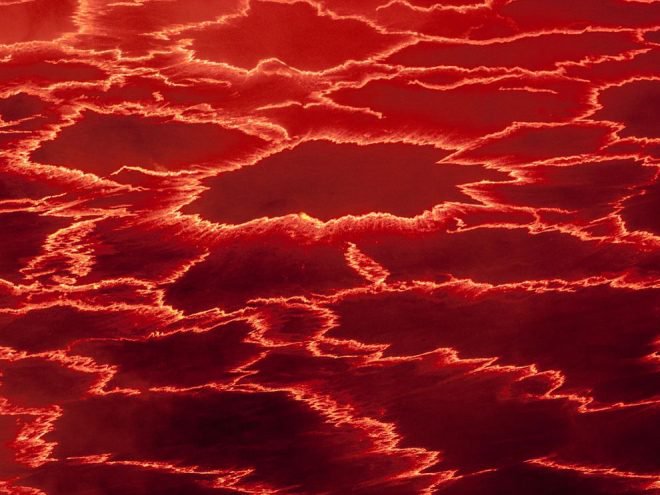
March 31, 2017
Feature Story
The Magma Ocean and Us

A vast magma ocean covered the very early Earth in its late period of formation, the likely result of heat from impacts as materials large and small fell to Earth. The magma ocean climbed to temperatures of 2000˚F and well above, and reached depths of hundreds of miles. Magma breaks the surface now only rarely in volcanic eruption, when it is called lava. This lava lake sits in Mount Nyiragongo, Democratic Republic of Congo. (National Geographic)
In the late stages of the formation of Earth, the planet was a brutally hot, rough place. But perhaps not precisely in the way you might imagine.
Most renderings of that time show red-hot lava flowing around craggy rocks, with meteorites falling and volcanoes erupting. But according to those who study the time, the reality was rather different.
There was most likely no land much of the time, the medium to large meteorites arrived every few thousand years , and the surface was the consistency of a kind of room-temperature oil. Of course it was not oil, since this was a pre-organic time. Rather, it was mostly molten silicates and iron that covered the Earth in a “magma ocean.”
At its most extreme, the magma ocean may have been as deep in places as the radius of Mars. And it would have created thick atmospheres of carbon dioxide, silica dust, other toxic gases and later water vapor.
While meteor impacts did play a major role in those earliest days, the dynamics of the magma ocean were more determined by the convection currents of the super-hot magma (2000 degrees F and more), the high winds blowing above the surface, the steam atmosphere it often created, and ultimately by the cooling that over hundreds of million of years led to the formation of a solid crust.
There is a burgeoning scientific interest in the magma ocean, which is expected to be part of the formation of any terrestrial planet and some lunar formations. The research focuses on gaining an understanding of the characteristics and diversity of magma oceans, and increasingly on the potentially significant role it plays in the origin of life on Earth, and perhaps elsewhere.
The reason why is pretty simple: life (i.e., biochemistry) emerged on Earth from geochemistry (i.e., rocks and sediment). Some of the earliest geochemistry occurred in the magma ocean, and so it makes sense to learn as much as possible about the very earliest conditions that ultimately led to the advent of biology.
What’s more, scientists believe that magma oceans created the conditions that allowed molten iron to drop down to form the planet’s core (necessary for creating magnetic fields) that resulted in the formation of more complex and thick atmospheres and produced water cycles. All are essential for the formation of a habitable planet and for the emergence of life.